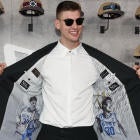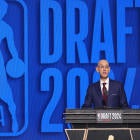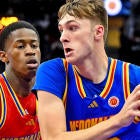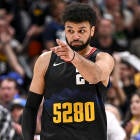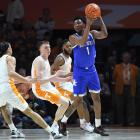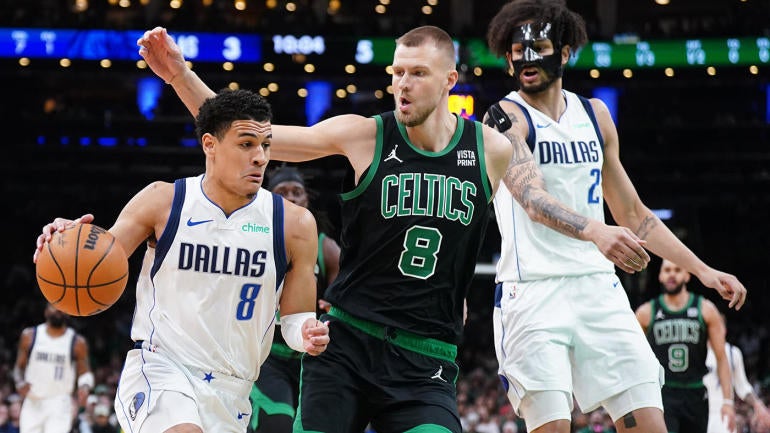
Kristaps Porzingis is not the same player he was in Dallas. In his first season with the Boston Celtics, he has punished teams for switching smaller players onto him and anchored the league's second-best defense. Years after being cast as Luka Doncic's co-star -- when he joined the Mavericks in 2019, then coach Rick Carlisle said, "This is kind of a Dirk-and-Nash type of situation, only these guys are taller" -- he is now part of a fearsome fivesome. Porzingis is capable of scoring 30-plus points on any given night, but averaged 20 and can change games without tons of touches.
Dallas is not the same team it was when Porzingis was there, either. Kyrie Irving is now Doncic's co-star, and the roster is full of low-usage role players who have passed every test in these playoffs. After making two trades in February and settling on a starting lineup in March, the Mavericks have become an elite defensive team in their own right. They have athletic wings who tie lineups together, shooters who feast on open looks and a two-headed monster in the middle. Centers Dereck Lively II and Daniel Gafford protect the rim, catch lobs and are having the time of their lives.
What the Mavs don't have anymore, though, is a 7-foot-2 dude with deep range and a quick trigger. Porzingis is the kind of matchup problem that Dallas might not be able to solve, and, in the NBA Finals, he has a chance to show his former team what it is missing. Coming off a calf injury, he could be the key to the series.
'If I were the player that I am right now…'
One of the reasons that Boston had the most efficient regular-season offense in NBA history is that it spaces the floor as well as any team ever has. When bigs guard Porzingis, he drags them away from the basket, and because the Celtics have shooters and playmakers all over the court, there isn't a natural hiding spot elsewhere. This forces opposing coaches to ask themselves questions, like, "Should we try putting Gafford on Jrue Holiday?"
Porzingis has always been a sharpshooter on the perimeter. After leaving Dallas, though, he turned into a post-up threat. Carlisle famously didn't want to give him the ball with his back to the basket, and, in fairness, it wasn't an efficient proposition back then. Boston, though, saw how Porzingis dominated smaller defenders with the Washington Wizards, and it believed he could diversify its offense. When defenses are switching in an effort to lure you into stagnant isolation play, it helps to have a giant who can simply shoot over people from the free-throw line in.
"Maybe if Rick knew that I could be this effective, he would have had more patience," Porzingis told The Athletic's Jared Weiss. "So I just really improved my game in the post and probably if I were the player that I am right now (when I went) to Dallas, Rick would look at it differently."
When Porzingis was with the Mavericks, the book on them was to go small and switch. The Celtics weren't afraid to put Marcus Smart on Porzingis, and the New Orleans Pelicans put Holiday on him. When the Los Angeles Clippers' Kawhi Leonard hounded him during the 2021 playoffs, it effectively took him out of the series -- Dallas decided its best option was to put Porzingis in the corner, which at least kept Leonard occupied.
In theory, Dallas could try something similar in the Finals. PJ Washington and Derrick Jones Jr. each have a wingspan longer than 7 feet, and the latter is one of the most switchable defenders in the NBA. Neither is as strong as Leonard, though and, in addition to the where-do-you-put-the-center conundrum, Porzingis is a tougher cover these days. When he posts up, he's looking to turn and shoot or, if he catches the ball low enough, go into mash mode. He's less turnover-prone than he used to be since he rarely tries to put the ball on the floor in traffic.
Porzingis has both simplified and expanded his offensive game in the last two-plus seasons. Being a more capable one-on-one scorer has made him a more dangerous handoff hub and roll man. And when defenses double him in the center of the court, he usually makes the right pass, since he can see over everybody and Boston's spacing is pristine. This is scary because, as Lively put it, the Celtics "shoot the shit out of the ball."
'Man, I was so stationary'
From when he was flying in for putback dunks as a rookie in New York to when he was out of the spotlight in D.C., the allure of Porzingis has been the same: He's a skilled stretch 5 who can protect the rim. Unlike many other tall and talented shooters, Porzingis showed from the get-go that he could move his feet on defense and, despite his slight frame, was willing to challenge anybody who attacked the paint.
During his time with the Mavericks, though, all the talk about his All-Defense potential disappeared. He was an effective enough deterrent around the basket in his first season in Dallas, having recovered from a torn ACL in his left knee, but after he tore the meniscus in his right knee during the 2020 playoffs, it was a different story. The following season, opponents routinely and relentlessly targeted him in pick-and-rolls, and he struggled to defend in space.
"Man, I was so stationary," Porzingis told JJ Redick during a podcast appearance earlier this season. "Like honestly, realistically, the criticism that I was getting, it was for a good reason."
Porzingis said that, just like with his post-up game, he had to take responsibility for his defensive shortcomings and work to correct them. In offseason workouts, he focused on flexibility, balance and mobility rather than strength. Under Celtics coach Joe Mazzulla, Porzingis has mostly played drop coverage against pick-and-rolls, which allows them to stay out of rotation and limit corner 3s and shots at the rim. In certain situations, though, Porzingis has come up to the level of the screen, switched and blitzed.
In Boston, opponents have still sometimes targeted Porzingis. They've done this, though, because of how great his teammates are defensively, not because he's some kind of liability. And it doesn't always work out the way they envision it. If the Celtics would prefer to keep him in the paint, they will often pre-switch; one of their many small success stories this season is Holiday evolving into a Smart-esque backline communicator, pointing teammates to where they need to be. And when Porzingis finds himself on an island, he usually has multiple All-Defense types behind him, rather than, say, Doncic, Tim Hardaway Jr. and Jalen Brunson.
Boston has been creative with matchups, so Porzingis could start most defensive possessions on Thursday guarding Washington or Jones rather than Gafford or Lively. Regardless, don't be surprised if Doncic calls Porzingis' man up to set a screen on the first play of the game. Porzingis has been sidelined since hurting his calf in the first round, and if his lateral movement is compromised, the Mavericks will surely exploit this as much as they can. Heading into the Finals, how Boston's defense fares in these situations is as big a variable as any. If Porzingis holds up as well as he did throughout the season, his former team will be in trouble.











